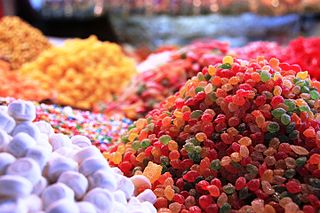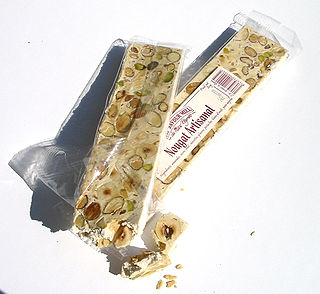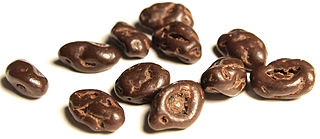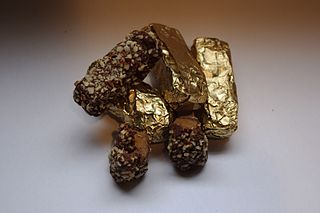
Confectionery is the art of making confections, which are food items that are rich in sugar and carbohydrates. Exact definitions are difficult. In general, however, confectionery is divided into two broad and somewhat overlapping categories: bakers' confections and sugar confections. The occupation of confectioner encompasses the categories of cooking performed by both the French patissier and the confiseur.

Candy, alternatively called sweets or lollies, is a confection that features sugar as a principal ingredient. The category, also called sugar confectionery, encompasses any sweet confection, including chocolate, chewing gum, and sugar candy. Vegetables, fruit, or nuts which have been glazed and coated with sugar are said to be candied.

Chad refers to fragments sometimes created when holes are made in a paper, card or similar synthetic materials, such as computer punched tape or punched cards. The word "chad" has been used both as a mass noun and as a countable noun.

Nougat is a family of confections made with sugar or honey, roasted nuts, whipped egg whites, and sometimes chopped candied fruit. The consistency of nougat is chewy, and it is used in a variety of candy bars and chocolates. The word nougat comes from Occitan pan nogat, seemingly from Latin panis nucatus 'nut bread'.

A ticker-tape parade is a parade event held in an urban setting, characterized by large amounts of shredded paper thrown onto the parade route from the surrounding buildings, creating a celebratory flurry of paper. Originally, actual ticker tape was used, but now mostly confetti is substituted.

A garnish is an item or substance used as a decoration or embellishment accompanying a prepared food dish or drink. In many cases, it may give added or contrasting flavor. Some garnishes are selected mainly to augment the visual impact of the plate, while others are selected specifically for the flavor they may impart. This is in contrast to a condiment, a prepared sauce added to another food item primarily for its flavor. A food item which is served with garnish may be described as being garni, the French term for "garnished."

A dragée, is a bite-sized confectionery with a hard outer shell.

Chocolate-covered raisins are a candy consisting of individual raisins coated in a shell of milk, dark or white chocolate.

Mounds is a candy bar made by The Hershey Company, consisting of shredded, sweetened coconut coated in dark chocolate. The company also produces the Almond Joy, a similar bar topped by whole almonds and covered in milk chocolate. The two products share common packaging and logo design, with Mounds using a red color scheme and Almond Joy blue.
Mithai (sweets) are the confectionery and desserts of the Indian subcontinent. Thousands of dedicated shops in India, Bangladesh, Nepal, Pakistan and Sri Lanka sell nothing but sweets.

A sugar plum originated as a piece of dragée or hard candy made of hardened sugar in a small round or oval shape.
The Ferrara Candy Company is an American candy manufacturer, based in Chicago, Illinois, and owned by the Ferrero Group.

A cascarón is a hollowed-out chicken egg filled with confetti or small toys. Cascarones are common throughout Mexico and are similar to the Easter eggs popular in many other countries. They are mostly used in Mexico during Carnival, but in American and Mexican border towns, the cultures combined to make them a popular Easter tradition.

The Carnival of Basel is the biggest carnival in Switzerland and it is the main Protestant carnival in the world. Basler Fasnacht takes place annually between February and March in Basel. It has been listed as one of the top fifty local festivities in Europe.

A party favor is a small gift given to the guests at a party as a gesture of thanks for their attendance, a memento of the occasion, or simply for fun.

A ticket punch is a hand tool for permanently marking admission tickets and similar items of paper or card stock. It makes a perforation and a corresponding chad. A ticket punch resembles a hole punch, differing in that the ticket punch has a longer jaw and the option of having a distinctive die shape. A ticket punch resembles a needle punch in that it makes a distinctive pattern in the item punched, but differs in that it makes a chad.

Almond Roca is a brand of chocolate-covered, hard toffee with a coating of ground almonds. It is similar to chocolate-covered English toffee. The candy is manufactured by the Brown & Haley Co. of Tacoma, Washington, founded in 1912 by Harry Brown and J.C. Haley.

Cocada are a traditional coconut confectionery found in many parts of Latin America and Europe. They are particularly popular in Argentina, Bolivia, Brazil, Colombia, Chile, the Dominican Republic, Cuba, Spain, Mexico, Panama, Venezuela Ecuador And Goa Former Estado da Índia Portuguesa.




















